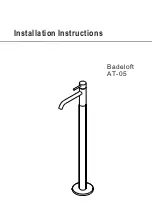
Electrical Planning Notes:
Reference below, for schematic wiring diagram example. Use electrical components as described including
electrical connectors that are appropriate for the operating environment of the fuel system, whether its use in street,
racing, or marine applications. Electrical connectors for the power leads must be capable of high current draw,
note all connections, wire, and component rating requirements herein. Solder and use shrink wrap for wire splices
for extra reliability. Main wiring schematic diagram below shows the control of relay by ignition switch. This source
can be changed as described, or by a toggle switch. Some forms of racing have specific rules regarding electrical
switching of fuel system. Consult appropriate racing guidelines, rules, and regulations.
Speed Control: A “PWM (Pulse Width Modulation) Signal” is a signal that alternates between a “High” voltage level
that is limited to approximately 5 Volts to near 0 Volts or ground level (relative to the Power Ground Wire). The
signal shape is typically a square wave (when viewed on an oscilloscope) at a fixed frequency. This signal is
measured differentially between the PWM Signal (White) Wire and the Power Ground (Black) Wire. The ratio of the
signal being “High” vs. “Low” defines the “Dwell Time” in percentage. The Controller interprets a PWM signal’s
“Dwell Time” range between 5% and 95% to communicate pump flow performance between the minimum speed
available and the maximum speed available, respectively. If the Controller fails to interpret or losses the signal, the
Controller will default to the maximum speed (or flow) setting. Electronic devices such as Engine Management
Units may have an output that can produce PWM Signals compatible with this Controller. Attach this white signal
wire to ground to operate system in Full Speed Mode (not using speed control).
MAIN WIRING SCHEMATIC DIAGRAM:
(Some electrical components shown are not supplied with kit)
Installation Steps:
1. Disconnect the ground terminal from battery and allow the vehicle’s engine and exhaust system to cool.
Relieve fuel system pressure per applicable service manual. Follow all Warnings, Cautions and Instructions
written on previous pages of these instructions.
2. Modify, remove, or replace other fuel system components as required per established build plan (reference
notes on previous pages and above).
3. Remove the fuel tank or cell from the vehicle, noting all precautions regarding fuel vapors being
EXPLOSIVE
on the first page herein (if applicable). Installer is responsible for all fabrication necessary to mount and seal
the fuel pump to fuel cell or fuel tank. Cork Flange Gasket is provided to assist in sealing flange. Installer is
also responsible for securing inlet straining filter system. Follow Steps 3A through 3i to install Fuel Pump to
fuel cell / fuel tank. Extra Flange-adapting installation kit is available per Fuelab Model 20931. If using that kit
for installation, follow those instructions for these steps, not herein.
Model 93901
FUEL PUMP
(12-14ga)
FUSED
(16-20ga)
or ECM
BLK
-
+
RED
VEHICLE BATTERY
IGNITION
(16-20ga)
NO
(12-16 Volt System)
C
NC
VEHICLE ELECTRICAL SYSTEM
WHT
(12-14ga)
FUEL PUMP
POWER RELAY
(25+A Rating)
(1-5A)
(12-14ga)
CIRCUIT
SWITCH
Speed Control Wire (White). Device or circuit
can be used as described, for proper operation.
CIRCUIT
BREAKER
or FUSE
(20A)
110021251-1, Rev B Sheet 3 of 8


























